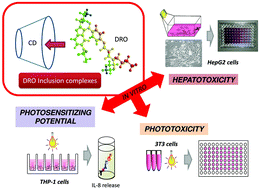Comparative evaluation of the hepatotoxicity, phototoxicity and photosensitizing potential of dronedarone hydrochloride and its cyclodextrin-based inclusion complexes†
Abstract
In this study, the hepatotoxicity, phototoxicity and photosensitizing potential of free dronedarone (DRO) and its inclusion complexes with β-cyclodextrin (β-CD) and 2-hydroxypropyl-β-cyclodextrin (HP-β-CD), prepared by different methods, were investigated by using in vitro cell-based approaches. The results of the 3T3 NRU phototoxicity assay showed that free DRO and the CD-based inclusion complexes did not present any substantial phototoxic potential. The photosensitizing potential was assessed by using THP-1 cells and IL-8 as a biomarker, and the experimental data confirmed that both the free drug and the inclusion complexes are likely to cause skin photosensitization, as they were able to induce IL-8 release after irradiation. Nevertheless, the inclusion complexes obtained by kneading followed by spray-drying induced a lower IL-8 release and also presented a smaller stimulation index in comparison with free DRO, suggesting a reduction in the photosensitizing potential. Finally, the free drug and inclusion complexes were also tested for hepatotoxicity using HepG2 cells. Even though lower IC50 values were found for the inclusion complexes prepared by kneading followed by spray-drying, there was no significant difference, indicating that the complexation of dronedarone did not induce hepatotoxicity. Overall, the obtained data confirmed that the inclusion complexes prepared by kneading followed by spray-drying, especially those based on HP-β-CD, appeared to be the most promising formulations and, therefore, could be encouragingly explored in the development of novel pharmaceutical dosage forms containing DRO, presumably with reduced side effects and improved safety profile.



 Please wait while we load your content...
Please wait while we load your content...